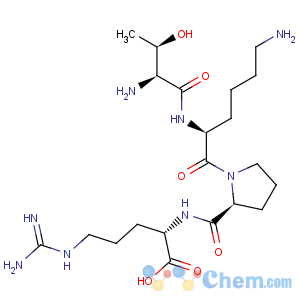Title: Tuftsin
CAS Registry Number: 9063-57-4
CAS Name: L-Threonyl-L-lysyl-L-prolyl-L-arginine
Synonyms: N2-[1-(
N2-L-threonyl-L-lysyl)-L-prolyl]-L-arginine
Molecular Formula: C21H40N8O6
Molecular Weight: 500.59
Percent Composition: C 50.39%, H 8.05%, N 22.38%, O 19.18%
Literature References: A naturally occurring tetrapeptide having a variety of immunopotentiating properties, especially stimulation and enhancement of phagocytosis. It also exhibits antitumor and antibacterial activity and has been shown to possess chemotactic, migration-enhancing, and mitogenic properties for leukocytes. Discovered during research on the physiological role of cytophilic gamma-globulin: V. A. Najjar, K. Nishioka,
Nature 228, 672 (1970). Produced in the spleen; present in mammalian blood in the gamma globulin fraction as part of the larger molecule
leucokinin. Isoln and characterization: K. Nishioka
et al., Biochim. Biophys. Acta 310, 217 (1973); V. A. Najjar,
US 3778426 (1973 to Research Corp.). Solid phase synthesis: K. Nishioka
et al., Biochem. Biophys. Res. Commun. 47, 172 (1972);
eidem, Biochim. Biophys. Acta 310, 230 (1973). Synthesis by fragment condensation: J. Vicar
et al., Collect. Czech. Chem. Commun. 41, 3467 (1976); by liquid phase method: S. Nozaki
et al., Bull. Chem. Soc. Jpn. 50, 422 (1977). 13C-NMR and circular dichroism studies: I. Z. Siemion
et al., Eur. J. Biochem. 112, 339 (1980). Conformational studies have provided conflicting evidence on the structure,
cf. M. Blumenstein
et al., Biochemistry 18, 4247 (1979). Specific receptors on macrophages, monocytes, and granulocytes are thought to mediate the biological activity of tuftsin: A. Constantopoulos, V. A. Najjar,
J. Biol. Chem. 248, 3819 (1973); R. M. G. Nair
et al., Immunochemistry 15, 901 (1978); Z. Bar-Shavit
et al., Biochem. Biophys. Res. Commun. 94, 1445 (1980). Its physiological significance has been shown in patients in whom tuftsin deficiency has resulted in a human syndrome with increased incidence of severe infections:
Macrophages and Lymphocytes, Part A, M. R. Escobar, H. Friedman, Eds. (Plenum Press, New York, 1980) pp 131-147;
Lymphokine Reports, E. Pick, Ed. (Academic Press, New York, 1980) pp 157-159; V. A. Najjar,
Med. Biol. 59, 134 (1981). General biological properties: V. A. Najjar,
Mol. Cell. Biochem. 41, 1 (1981). Antitumor activity: K. Nishioka
et al., ibid. 13. Bactericidal activity: J. Martinez, F. Winternitz,
ibid. 123. Analogs: F. Z. Siemion,
ibid. 99.
Reviews: V. A. Najjar,
Exp. Cell Biol. 46, 114-126 (1978);
eidem, Adv. Exp. Med. Biol. 121A, 131-147 (1980); K. Nishioka
et al., Life Sci. 28, 1081-1090 (1981); V. A. Najjar,
Mol. Cell. Biochem. 41, 73-98 (1981). Conference proceedings:
Ann. N.Y. Acad. Sci. 419, entitled "Antineoplastic, Immunogenic and Other Effects of the Tetrapeptide Tuftsin: a Natural Macrophage Activator", V. A. Najjar, M. Fridkin, Eds. (1983) pp 1-273.

